E-Museum of Pyrographic ArtAntique Art Hall
|
| - Café Flambé - | - Portraits and Paintings - | - Decorative and Applied Art - |
| - Folk and Traditional Art - | - Antique Art - | - Special Hall - | - Sculpture - |
| - Children's Hall - | - Bookstore and Library - | - Tools and Techniques - |
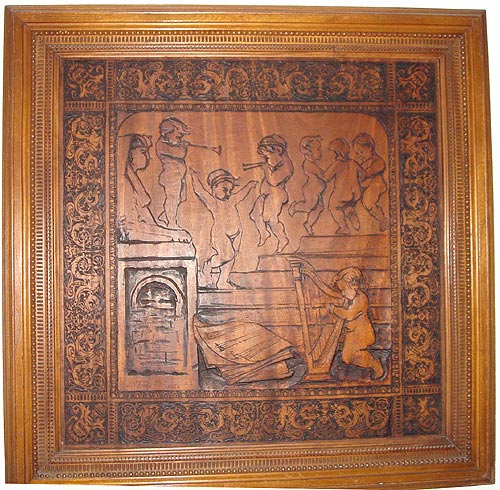 |
| Untitled (Frolicking Cherubs), By J. William Fosdick, 1884 Pyrography on framed wood panel, 22.5 in. by 22.5 in. (inside frame) and 29 in. by 29 in. (outside frame) Digital image courtesy of the owner |
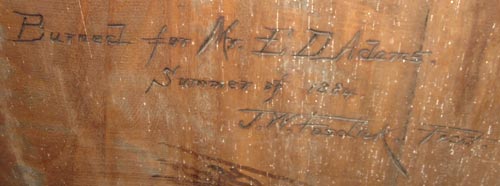 |
| Untitled (Frolicking Cherubs), Detail of the inscription, verso By J. William Fosdick, 1884 Inscription on the verso is the following: Burned for Mr. E. D. Adams.Pyrography on framed wood panel, 22.5 in. by 22.5 in. (inside frame) and 29 in. by 29 in. (outside frame) Digital image courtesy of the owner |
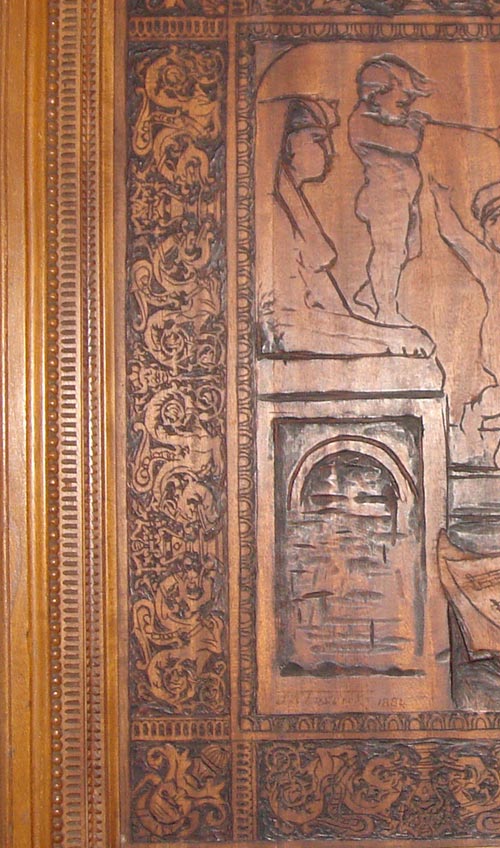 |
| Untitled (Frolicking Cherubs), Detail of the left border, recto By J. William Fosdick, 1884 Pyrography on framed wood panel, 22.5 in. by 22.5 in. (inside frame) and 29 in. by 29 in. (outside frame) Digital image courtesy of the owner |
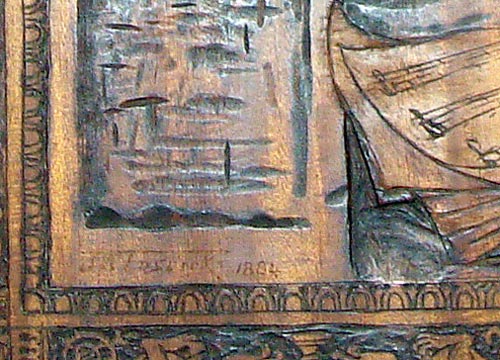 |
| Untitled (Frolicking Cherubs), Detail of the signature, recto By J. William Fosdick, 1884 Faint inscription on the recto: J. W. Fosdick. 1884.Pyrography on framed wood panel, 22.5 in. by 22.5 in. (inside frame) and 29 in. by 29 in. (outside frame) Digital image courtesy of the owner |
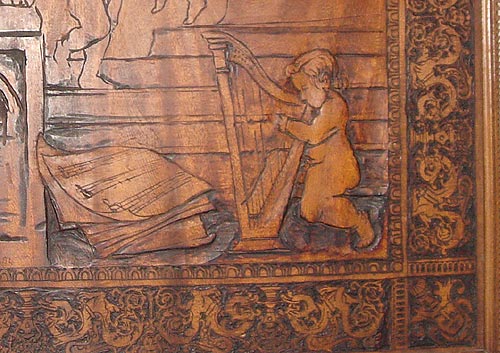 |
| Untitled (Frolicking Cherubs), Detail of the cherub and harp in the lower portion, recto By J. William Fosdick, 1884 Pyrography on framed wood panel, 22.5 in. by 22.5 in. (inside frame) and 29 in. by 29 in. (outside frame) Digital image courtesy of the owner |
 |
| Untitled (Frolicking Cherubs), Detail of the border in the upper left corner By J. William Fosdick, 1884 Pyrography on framed wood panel, 22.5 in. by 22.5 in. (inside frame) and 29 in. by 29 in. (outside frame) Digital image courtesy of the owner |
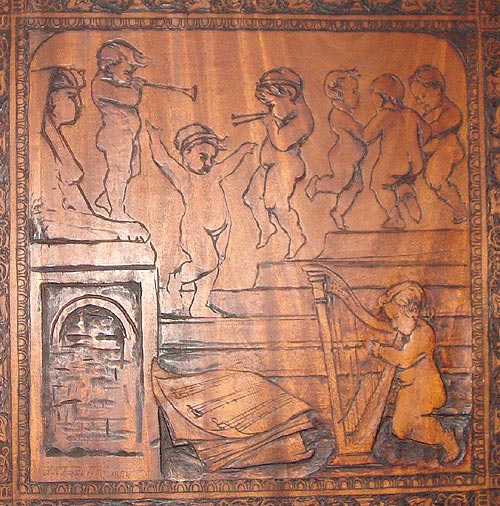 |
| Untitled (Frolicking Cherubs), Detail of the Figures By J. William Fosdick, 1884 Pyrography on framed wood panel, 22.5 in. by 22.5 in. (inside frame) and 29 in. by 29 in. (outside frame) Digital image courtesy of the owner |
American Richard Reinhardsen of Massachusetts, inherited this whimsical panel of frolicking cherubs from his mother, who had inherited it from his grandmother; she had inherited it from her first husband, Ernest Kempton Adams, who was the son of Edward Dean Adams. Edward Dean Adams was born in Boston in 1846. He is the "E. D. Adams" of the "summer of 1884" dedication on the back of Fosdick's panel.
In regard to the curious composition of cherubs and a sphinx, it seems the subject matter was not of great significance for either the artist or his client, so much as that the themes of cherubs and sphinx statues were both very popular at that time. There were similar statues of the sphinx in the Metropolitan Museum of Art in New York and a fountain of such statues was one of the illustrations in an autobiographical travelogue by Fosdick about Fontainebleau (cited in his Salon No. 3 in the E-Museum).
The historic importance of this panel lies in the belief that it is related to J. William Fosdick's first commission—in 1884—as a professional artist and using pyrography. It launched his very successful career in "fire etching" as he called it then and likely provided him social and professional access to prominent members of New York, St. Louis, Washington, and Boston society.
It is known that Fosdick's commission for a frieze in pyrography came through a very prestigious architectural firm of that time, the same one that designed the White House in Washington, D.C.: McKim, Mead & White.
Here is the story of that 1884 commission in Fosdick's own words from his December 1891 article in Art Interchange Magazine:
"One day a New York millionaire conceived the idea of having his hall built with light mahogany with a Renaissance frieze burned about the top. He consulted his architects Messrs. McKim, Meade [sic] & White who agreed that it would be harmonious. He wrote to Mrs. Hughes begging that she would tell him who could perform this task. She wrote back that the only person who had done the work in Boston since the days of Mr. Hughes was a young school boy named Fosdick and he had gone abroad. The result was that I left my work in Paris and crossed the Atlantic expressly to burn this frieze. It proved a success and from that time I took up the study of burnt wood decoration seriously and devoted myself to it exclusively."
By the time Fosdick wrote his aforementioned article in 1891, he had completed his studies in Paris in 1888, returned to the United States and spent two years in which he exhibited his pyrography work in New York, Washington, and St. Louis. By then his work was decorating "many of the richest homes of America, principally in New York and St. Louis."
It has now been verified that this commission, as was believed (precisely because of the clues from this panel of the cherubs), came from the very prominent financier of that time to whom the dedication on this curious panel was made—Edward Dean Adams, known as E. D. Adams—the financier known for bringing electricity to America. His own fascinating biography is told in the 1929 Time Magazine cover story linked here.
It has now also been ascertained that Fosdick's architectural commission did not relate to the E. D. Adams family's New Jersey estate called Rohallion in Lakewood, as first supposed, but rather to the Villard group of houses behind St. Patrick's Cathedral in New York City of which E. D. Adams owned the one at 455 Madison Avenue—the exact address of what is now the Palace Hotel.
The E-Museum has now verified where Fosdick's panels went when E. D. Adams' house was gutted at the time the Palace Hotel was built. Barry Harwood, Curator of the Brooklyn Museum's Decorative Arts collection confirmed that they have the panels in their archives. In December of 2003, the New York Times published a wonderful narrative of the 1884 Villard Houses, historic landmark architecture that stands today as a tribute to the great 19th Century artists and architects of the Gilded Age.
NEWSFLASH!
The letter from Ball Hughes' widow Eliza in reply to E. D. Adams.
This link is to a transcript of the actual letter that led to the commission for J. William Fosdick's first professional opportunity using the pyrographic technique. Although the undated letter was originally thought to date back to about 1880, it now seems probable that Eliza Ball Hughes wrote it in (or at least closer to) 1884. This letter, known to the E-Museum but which text was heretofore unavailable, was recently found in research done by Ball Hughes' descendant David Brown and quoted in a web page he prepared primarily to display his ancestor's first ever poker-work, which was recently rediscovered in the Brown family's private collection.
A couple of distant photographs and a brief description of Fosdick's panels appeared in the book, THE VILLARD HOUSES: Life Story of a Landmark by William C. Shopsin and Mosette Glaser Broderick, Viking Press, New York, p. 90: "In the frieze surrounding the upper portions of the parlor floor living hall were burnt wood panels executed in situ by James Fosdick, ..."
And finally, comes this excerpt from a story by a New York Times reporter in 1892 recounting the summer of 1884 from an interview with J. William Fosdick. It seems to contradict the account in the book, but perhaps the very first and/or last bit of the project was on location at the house, so that both accounts may be true:
"In the Summer of 1884 Mr. Fosdick returned to the United States to do Mr. Adams's work. He fitted up a studio in an old schoolhouse on a farm in Westborough, Mass. The panels were sent to him from New York. During one of the hottest of Summers he devoted himself to a laborious task. The fine tools that the beauty and popularity of fire etching have since called into existence were then unknown. Mr. Fosdick was obliged to roast himself over a charcoal furnace. His irons were of the most primitive kind. They were pieces of metal fastened into copper tubes, with plaster of paris as a non-conductor of the heat..."
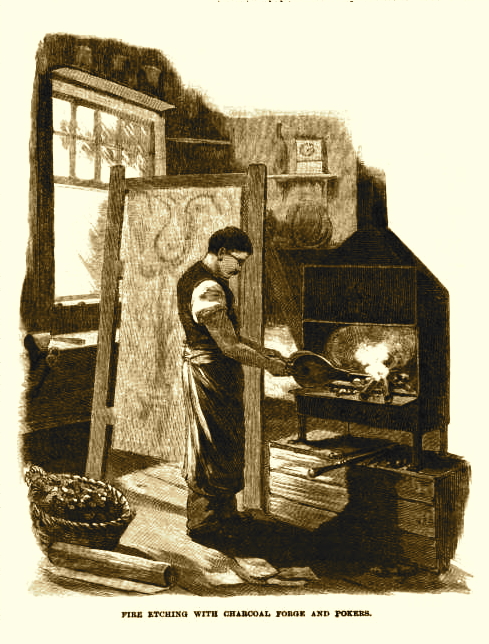 |
| FIRE ETCHING WITH CHARCOAL FORGE AND POKERS From Etching with Fire by Franklin Smith, 1892 |
"Mr. Fosdick's completion of the panels justified Mr. Adams's faith in the fire etcher's art. When set in place they became objects of general admiration. They were not merely novel, they were beautiful, and harmonized perfectly with the finish and decoration of the room....To the eye of the prophet it was clear that an old art was about to assume new beauty..."
If you have either any questions to ask or any information to offer regarding this decorative panel from 1884, or the panels that were done for the Adams family's Villard house at 455 Madison Avenue, please e-mail Richard Reinhardsen and the E-Museum Curator.
You are leaving the J. William Fosdick Salon
Featuring his 1884 Panel of Cherubs.
You can return to the:
Antique Art Hall
where there is a large section
with many exhibits dedicated to J. William Fosdick
or continue on your tour to one of the following
Pyrographic Art Exhibit Halls:
Portraits and Paintings
Decorative and Applied Art
Sculpture
Folk and Traditional Art
Children's Pyrographic Art
Special Pyrographic Art
The Book Store and E-Museum Library exhibits
Pyrographic Tools exhibit
Your questions and comments are welcome and appreciated. Please e-mail Curator.
Back to E-Museum Entrance homepage
©2008, 2009, 2010 Kathleen M. Garvey Menéndez, all rights reserved.
Last update on 21 March 2010.

